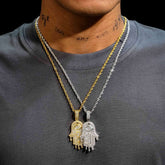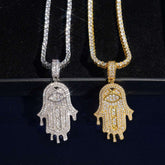Why is moissanite so expensive?
What is moissanite?
Moissanite is popular for its diamond-like dazzling appearance—it’s difficult to tell the difference unless you are well-versed in jewelry. This gem not only displays the same brilliant sparkle as diamonds and reflects light in an equally mesmerizing way, but it is much less expensive than diamonds, making moissanite a more economical choice.
In the gemology field, moissanite is esteemed for its appearance that rivals that of diamonds and its extraordinary durability. This silicon carbide gemstone not only has high hardness but also surpasses traditional diamonds in some optical properties, particularly in terms of dispersion (fire) and luster. Moissanite has a higher refractive index than diamonds, which produces more sparkle, and its birefringence adds a unique visual effect.
Additionally, moissanite’s chemical stability makes it less likely to absorb grease and stains, a feature deriving from its hydrophobic surface, allowing it to remain shiny even without frequent cleaning. In terms of durability, moissanite has a Mohs hardness close to that of diamonds, reaching 9.25, making it an ideal choice for everyday wear.
Environmentally, moissanite also demonstrates its advantages. Nearly all moissanite in the market is created in laboratories, which avoids the environmental damage caused by traditional gem mining and reduces carbon footprint. Lab-grown moissanite meets modern consumers' demands for sustainable and responsible jewelry, making this gem not only compete aesthetically with diamonds but also offers a strong choice in terms of ethics and environmental protection.
How was moissanite discovered?
In 1893, French chemist Henri Moissan (1852-1907) discovered natural crystals that looked remarkably similar to diamonds in a meteorite crater in Arizona, USA. Due to its luster and hardness, it was initially mistaken for diamond. This was the first discovery of moissanite.
Subsequent research revealed that it was composed of silicon carbide, an element not then found on Earth. In 1905, the crystal was named "moissanite" in honor of Dr. Moissan. However, natural moissanite comes from the galaxy and is a rare mineral on Earth, found only in a few meteorite craters. Thus, all moissanite available in the market today is synthetically produced.
Brief History of Moissanite:
-
1893: Dr. Moissan first discovered a natural crystal similar to diamond in Arizona, which was later named moissanite.
-
1904: Dr. Moissan determined the crystal was composed of silicon carbide, a then-new mineral not previously found on Earth.
-
1905: Gemologist George Kunz named the crystal moissanite in honor of Dr. Moissan.
-
1995: The American company Cree Inc., which produced silicon carbide, researched synthetic moissanite. That same year, a head of Cree established C3 Corporation. A diamond cutter proposed that properly cut crystals could create dazzling new jewelry. Cree and C3 scientists began a three-year research project to bring the brilliance and light of moissanite to consumers.
-
1996: C3 Corporation obtained the exclusive patent technology for producing moissanite, becoming the first company in the world to produce it.
-
1998: C3 introduced moissanite to the market as a "diamond alternative," achieving significant success in the international jewelry market within three years and promoting moissanite jewelry among young trendsetters.
How much does moissanite cost?
The pricing of moissanite rings is very reasonable. For example, a nearly colorless 1-carat diamond typically costs about $5,000, while a completely colorless moissanite of the same carat weight (chemical formula: SiC, silicon carbide) is priced at about $500.
For larger moissanites, the price increases progressively, reflecting the gemological principle that the carat weight directly affects its market value. Specifically, a typical market price for a 2-carat moissanite engagement ring is about $1,200, while a 3-carat moissanite costs about $2,800.
How is moissanite graded?
Moissanite is generally graded using the 4C standards: color, clarity, cut, and carat, similar to diamonds.
Color Grading:
-
E, F grade: Colorless
-
H, I grade: Near colorless
-
K grade: Shows tone
This grading system is similar to that used for natural or lab-grown diamonds, with the more colorless the gem, the higher its rating. Thus, colorless moissanites in the D to F range typically command higher prices because they appear purer visually and can reflect and refract light more effectively, enhancing the gem’s brilliance and fire. 
Cut Grading: Moissanite's cut grade is based on its polish quality and symmetry, both of which directly the gem’s light performance. Different moissanite shapes require specific cut proportions to ensure optimal light effects. Cut grades are classified as "general," "good," "very good," and "excellent." The finer the gem's cut, the better its light performance, and the higher its cut grade. Moissanites with a "very good" cut grade are recommended. These gems are usually cut shallower, presenting a broader surface that makes the stone appear larger than its actual carat weight visually. This cut not only optimizes the gem’s brightness and fire but also effectively increases its visual size.

Carat Weight: Carat weight is also a significant factor affecting the gem's price—the higher the carat weight, the greater the value of the gem. Carat is the unit for measuring the weight of a gem.
Clarity Grading: In gemology, moissanite’s clarity is assessed by observing inclusions inside the gem and blemishes on its surface. Gem grading includes different levels: AAAA, AAA, AA, A, and B quality. The higher the clarity grade, the fewer the inclusions and blemishes, thereby significantly enhancing its transparency and optical performance. The gem’s brilliance and light performance are generally proportional to its clarity. Gemologists use precise magnification equipment to identify these tiny internal features, which are minor but crucial in assessing high-quality gems. Typically, these microscopic flaws do not significantly impact the visual appeal of moissanite.
Why are hip hop pendants made of crushed moissanite still so expensive?
For hip hop pendants, even though they use crushed moissanite, their high cost can be attributed to the large amount of materials required and the precision craftsmanship involved. Each pendant needs a large number of moissanites to achieve a visually full and brilliant effect, such as about 2000 stones for a 3-inch pendant, and 2200 stones for a 4-inch pendant. This high demand not only increases the cost of materials but also significantly adds to the time and complexity involved in manually setting these stones.
Moreover, the production of hip hop pendants usually involves precious metals like silver, 10K gold, 14K gold, or even 18K gold, which inherently hold high value. The use of precious metals not only enhances the overall aesthetic and durability of the pendant but also accordingly raises the cost. The creation of these intricate pendants involves advanced craftsmanship, including precise setting techniques, to ensure that each moissanite is securely set in the pendant and displays the best possible brilliance and visual effect.Therefore, even though crushed moissanite is used, the high price of these hip hop pendants is due to the use of a large amount of high-quality gemstones, exquisite metal materials, and complex craftsmanship. These factors together make each hip hop pendant a crystallization of art and craftsmanship, far surpassing the value of ordinary jewelry.































































Leave a comment
All blog comments are checked prior to publishing